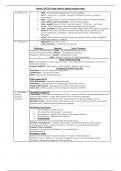Russia, 1917-91: from Lenin to Yeltsin revision notes
1a – Lenin 17-24 • WWI – poverty/starvation/opposition to Tsar, who abdicates
• Oct 17 – Lenin & Bols – revolution – Sovnarkom, All Russian Congress of Soviets, 13
revolutionaries.
• Marx’s 4 stages of history – Primitive Communism, Classical Slavery, Feudalism, Capitalism
• Lenin v Marx’s route to communism – Lenin said skip capitalism
• Lenin – popular: favoured workers, Sovnarkom support, 17-18 Decrees – Land, Peace,
Workers’ Control, let people do what was already happening? E.g. take land
• Lenin – unpopular: economy (Antonov/Kronstadt), Treaty of Brest-Litovsk, grain requsitioning
• CW 18-21 – economy ruined, War Communism used, Cheka & grain requisitioning, Tsar
generals in Red Army, centralisation, 1918 ignored election results, 1-Party state, less
democratic.
• 21 gov – banned factions, Soviets lost power, more capitalism (NEP), militarism (Cheka/RA),
centralised, Sovnarkom -> Politburo.
1b – Stalin 28-53 • Opponents all very close to Lenin.
• Lenin’s Testament – criticised Stalin & opponents
-----------------------------------------------------------------------------------------------------------------------
Weaknesses Opponent Lenin’s Testament
Disagreed on Bol Rev and NEP - Trotsky – too arrogant/willing to use violence
Too young, disagreed on WWI - Bukharin – misunderstood L’s ideology
Disagreed on Bol Rev timing - Zinoviev – disloyal before Oct Rev.
X Stalin – disloyal 22, L was too ill to fight back/impatient.
Causes of Great Terror (30s)
Kirov – growing authority, 1934 Congress of Victors – most votes. Killed, gave Stalin reason to claim anti-
communist conspiracy.
Economic problems – Stalin blames ‘wreckers/saboteurs’ (workers), sent to Gulags.
Consequences of Great Terror (30s)
Rivals gone – show trials, secret trials (by Red Army)
Leninists gone – new gen loyal to Stalin
NKVD – gained power. Beria gained power.
-----------------------------------------------------------------------------------------------------------------------
Stalin in power 28-53:
Chair of Sovnarkom – power over people/party/state.
Competition – appointed rivals who competed against each other, not him.
Frequent shift of power – kept rivals down, no power. Stalin stayed in power.
Terror state – officials purged, no enemies. People were scared so conformed.
1c – Khrushchev, Contenders for power 53:
Brezhnev, Lavrenti Beria – MVD head, not trusted by Khrushchev + Malenkov. MVD lost power (less gulag labour), tried
Andropov, and executed 53. Reforms – Gulags, MVD, Republics more inclusive (e.g. languages).
Chernenko Malenkov 53-55 – power base was the state – weakened by anti-bureaucracy campaign. Leninist.
Khrushchev 53-64 – Leninist/’maverick’. Beat Malenkov with success of Virgin Lands scheme, more support.
Weakened state + Malenkov with anti-bureaucracy campaign.
-----------------------------------------------------------------------------------------------------------------------
Khrushchev’s early reforms
• Anti-b campaign – weaken the state
• 44% Central Committee replaced – more support
• Democratisation – membership increased, seniors replaced regularly.
• Decentralisation – abolished central ministries.
• De-Stalinisation:
End mass terror/remove S’s cult of personality-decentralise the gov.
25 Feb 56 – Secret Speech – K criticised S at late-night, unscheduled meeting. 20th Party Congress.
K revealed scale of terror, L’s Testament about S, S’s mistakes – e.g. purging Red Army pre-WW2.
Stopped 57 due to problems:
Hungary rev – new pm ended USSR alliance – so K crushed the rev.
Destabilised the gov.
Khrushchev’s retreat
Backtracks on de-Stalinisation. agrees that people – not ready to know truth about S.
Attempted coup 57 – Malenkov + Presidium voted against K, who said Central Committee decides.
62 reforms – help economy, restart de-S, 50% ind 50% agr.
, Russia, 1917-91: from Lenin to Yeltsin revision notes
Brezhnev 64-82
Started with Kosygin – both wanted de-S, divided gov jobs equally/different top jobs to avoid emergence of
all-powerful leader.
Restoration – centralised the gov again. 77 Soviet Constitution – party > state power.
‘Stability of Cadres’ – no promotions/demotions = job security = gerontocracy.
Couldn’t advance, no incentive to work in gov. = stagnation.
Corruption – black market goods. B’s daughter’s lover – BtG – smuggled diamonds out.
------------------------------------------------------------------------------------------------------------------------
Andropov – 82-84
Old, minor reforms only – younger gen gov. Thought USSR should be more disciplined.
Brezhnev X – Cadres X Corruption X – BtG investigated.
------------------------------------------------------------------------------------------------------------------------
Chernenko 84-85
Too ill to rule. 13 months only. Old, minor reforms.
2a: Lenin economy Problems Lenin faced at start of the rev:
1917 – not many Marxists thought revolution was possible.
Russia not as advanced as the West.
WWI – economy ruined.
L introduced 3 main economic policies:
18 State capitalism – phase between capitalism/socialism.
• Based on nationalisation of industry – took factories from bourgeois owners, ending capitalism.
• Land reforms – popular, land split up and given to peasants.
18 War Communism – win the CW 18-21.
Food dictatorship Grain req, rationing
Labour discipline 1918) 11-hour working day
1919) compulsory labour 16-50
Harsh punishments for late/slacking
Abolition of the Money worthless – hyperinflation
market So money formally abolished.
Private trade – illegal.
Consequences Economic collapse 1921
Growth of the black market
Mass poverty
Political crisis.
No industrial workers – fled to farms for food.
1921 New Economic Policy – political/economic stability.
Measures: Grain req abolished, replaced → tax in kind, and bring money back.
Debate within party:
Left – should put agriculture under state, end private property.
Centre (Stalin) – pragmatic. 1921 NEP support, 1927 NEP no support.
Right – keep NEP, recover slowly. Keep peasants happy with land.
Successes: Popular, famine disappeared. economic/political stability.
Failures: Unpopular within party, corruption – poverty, gambling.
Scissors crisis – agriculture recovered quickly, farmers’ incomes dropped. Industry recovered slowly,
industrial prices rose. By 1923 – gap had reached crisis point, farmers couldn’t buy industrial goods and
had no incentive to work.
2b: Stalin economy 5-Year plans
1. Oct 28 – Dec 32
2. Jan 33 – Dec 37
3. Jan 38 – Jun 41
Successes : increased economic production
• Heavy industry increased the most, with transport/rearmament/labour productivity (Stakhanovites).
1940 – 1/3 gov spending rearmament.
1927 1940
Electricity (milliard kWhs) 5.05 48.30
Coal (million tons) 35.40 165.90
Oil (million tons) 11.70 31.10
Pig iron (million tons) 3.30 14.90
Steel (million tons) 4.00 18.30
Failures: pressure to meet targets
Managers lied about production levels, bad quality and wasteful/useless products.





